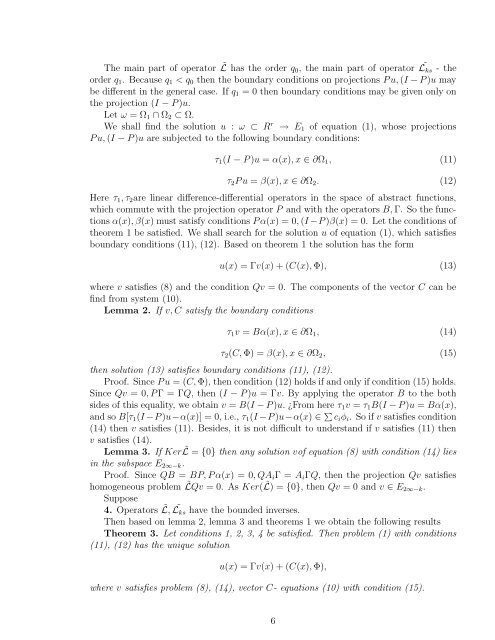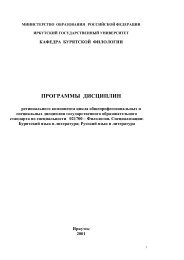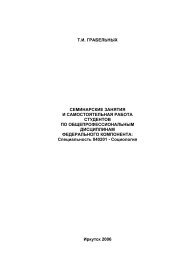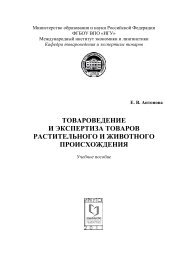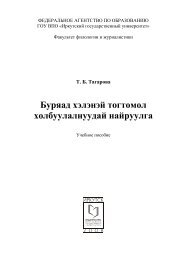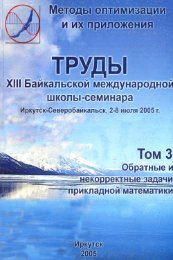Difference-differential Equations with Fredholm Operator in the Main ...
Difference-differential Equations with Fredholm Operator in the Main ...
Difference-differential Equations with Fredholm Operator in the Main ...
You also want an ePaper? Increase the reach of your titles
YUMPU automatically turns print PDFs into web optimized ePapers that Google loves.
The ma<strong>in</strong> part of operator ˜L has <strong>the</strong> order q 0 , <strong>the</strong> ma<strong>in</strong> part of operator Lks ˜ - <strong>the</strong><br />
order q 1 . Because q 1 < q 0 <strong>the</strong>n <strong>the</strong> boundary conditions on projections P u, (I − P )u may<br />
be different <strong>in</strong> <strong>the</strong> general case. If q 1 = 0 <strong>the</strong>n boundary conditions may be given only on<br />
<strong>the</strong> projection (I − P )u.<br />
Let ω = Ω 1 ∩ Ω 2 ⊂ Ω.<br />
We shall f<strong>in</strong>d <strong>the</strong> solution u : ω ⊂ R r → E 1 of equation (1), whose projections<br />
P u, (I − P )u are subjected to <strong>the</strong> follow<strong>in</strong>g boundary conditions:<br />
τ 1 (I − P )u = α(x), x ∈ ∂Ω 1 , (11)<br />
τ 2 P u = β(x), x ∈ ∂Ω 2 . (12)<br />
Here τ 1 , τ 2 are l<strong>in</strong>ear difference-<strong>differential</strong> operators <strong>in</strong> <strong>the</strong> space of abstract functions,<br />
which commute <strong>with</strong> <strong>the</strong> projection operator P and <strong>with</strong> <strong>the</strong> operators B, Γ. So <strong>the</strong> functions<br />
α(x), β(x) must satisfy conditions P α(x) = 0, (I −P )β(x) = 0. Let <strong>the</strong> conditions of<br />
<strong>the</strong>orem 1 be satisfied. We shall search for <strong>the</strong> solution u of equation (1), which satisfies<br />
boundary conditions (11), (12). Based on <strong>the</strong>orem 1 <strong>the</strong> solution has <strong>the</strong> form<br />
u(x) = Γv(x) + (C(x), Φ), (13)<br />
where v satisfies (8) and <strong>the</strong> condition Qv = 0. The components of <strong>the</strong> vector C can be<br />
f<strong>in</strong>d from system (10).<br />
Lemma 2. If v, C satisfy <strong>the</strong> boundary conditions<br />
τ 1 v = Bα(x), x ∈ ∂Ω 1 , (14)<br />
τ 2 (C, Φ) = β(x), x ∈ ∂Ω 2 , (15)<br />
<strong>the</strong>n solution (13) satisfies boundary conditions (11), (12).<br />
Proof. S<strong>in</strong>ce P u = (C, Φ), <strong>the</strong>n condition (12) holds if and only if condition (15) holds.<br />
S<strong>in</strong>ce Qv = 0, P Γ = ΓQ, <strong>the</strong>n (I − P )u = Γv. By apply<strong>in</strong>g <strong>the</strong> operator B to <strong>the</strong> both<br />
sides of this equality, we obta<strong>in</strong> v = B(I − P )u. ¿From here τ 1 v = τ 1 B(I − P )u = Bα(x),<br />
and so B[τ 1 (I −P )u−α(x)] = 0, i.e., τ 1 (I −P )u−α(x) ∈ ∑ c i φ i . So if v satisfies condition<br />
(14) <strong>the</strong>n v satisfies (11). Besides, it is not difficult to understand if v satisfies (11) <strong>the</strong>n<br />
v satisfies (14).<br />
Lemma 3. If Ker ˜L = {0} <strong>the</strong>n any solution vof equation (8) <strong>with</strong> condition (14) lies<br />
<strong>in</strong> <strong>the</strong> subspace E 2∞−k .<br />
Proof. S<strong>in</strong>ce QB = BP, P α(x) = 0, QA i Γ = A i ΓQ, <strong>the</strong>n <strong>the</strong> projection Qv satisfies<br />
homogeneous problem ˜LQv = 0. As Ker( ˜L) = {0}, <strong>the</strong>n Qv = 0 and v ∈ E 2∞−k .<br />
Suppose<br />
4. <strong>Operator</strong>s ˜L, Lks ˜ have <strong>the</strong> bounded <strong>in</strong>verses.<br />
Then based on lemma 2, lemma 3 and <strong>the</strong>orems 1 we obta<strong>in</strong> <strong>the</strong> follow<strong>in</strong>g results<br />
Theorem 3. Let conditions 1, 2, 3, 4 be satisfied. Then problem (1) <strong>with</strong> conditions<br />
(11), (12) has <strong>the</strong> unique solution<br />
u(x) = Γv(x) + (C(x), Φ),<br />
where v satisfies problem (8), (14), vector C- equations (10) <strong>with</strong> condition (15).<br />
6


